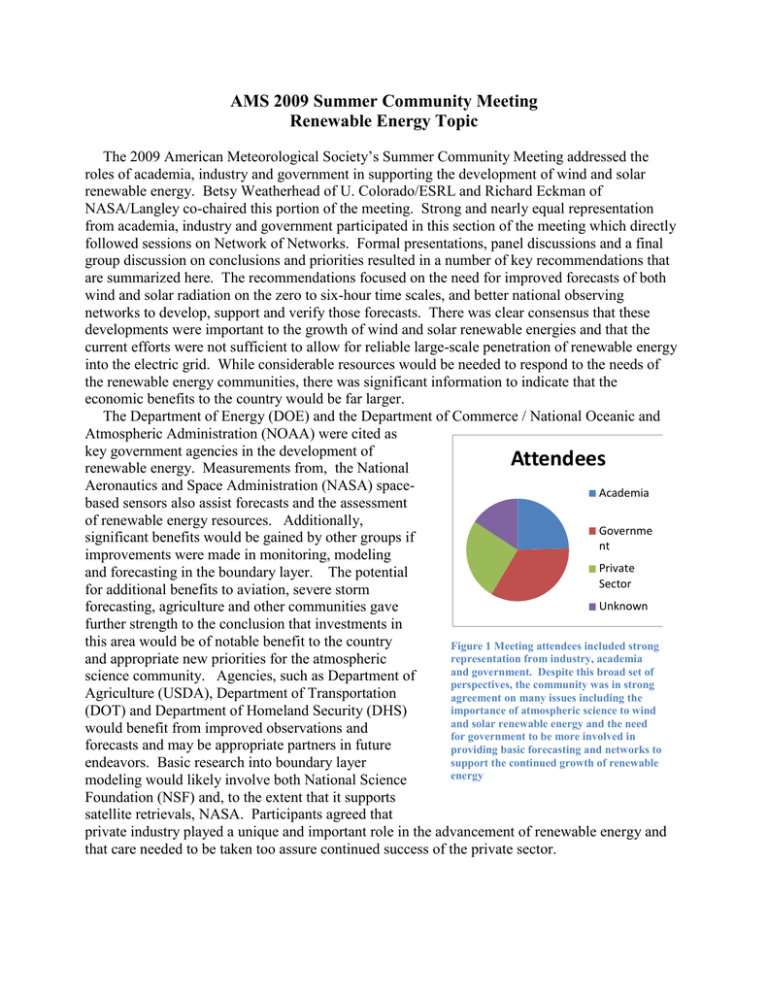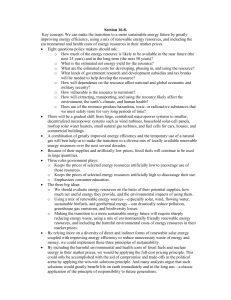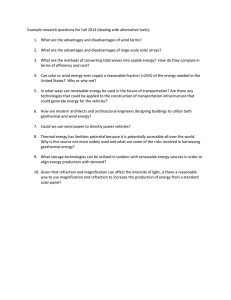AMS 2009 Summer Community Meeting Renewable Energy Topic
advertisement

AMS 2009 Summer Community Meeting Renewable Energy Topic The 2009 American Meteorological Society’s Summer Community Meeting addressed the roles of academia, industry and government in supporting the development of wind and solar renewable energy. Betsy Weatherhead of U. Colorado/ESRL and Richard Eckman of NASA/Langley co-chaired this portion of the meeting. Strong and nearly equal representation from academia, industry and government participated in this section of the meeting which directly followed sessions on Network of Networks. Formal presentations, panel discussions and a final group discussion on conclusions and priorities resulted in a number of key recommendations that are summarized here. The recommendations focused on the need for improved forecasts of both wind and solar radiation on the zero to six-hour time scales, and better national observing networks to develop, support and verify those forecasts. There was clear consensus that these developments were important to the growth of wind and solar renewable energies and that the current efforts were not sufficient to allow for reliable large-scale penetration of renewable energy into the electric grid. While considerable resources would be needed to respond to the needs of the renewable energy communities, there was significant information to indicate that the economic benefits to the country would be far larger. The Department of Energy (DOE) and the Department of Commerce / National Oceanic and Atmospheric Administration (NOAA) were cited as key government agencies in the development of Attendees renewable energy. Measurements from, the National Aeronautics and Space Administration (NASA) spaceAcademia based sensors also assist forecasts and the assessment of renewable energy resources. Additionally, Governme significant benefits would be gained by other groups if nt improvements were made in monitoring, modeling Private and forecasting in the boundary layer. The potential Sector for additional benefits to aviation, severe storm Unknown forecasting, agriculture and other communities gave further strength to the conclusion that investments in this area would be of notable benefit to the country Figure 1 Meeting attendees included strong representation from industry, academia and appropriate new priorities for the atmospheric and government. Despite this broad set of science community. Agencies, such as Department of perspectives, the community was in strong Agriculture (USDA), Department of Transportation agreement on many issues including the importance of atmospheric science to wind (DOT) and Department of Homeland Security (DHS) and solar renewable energy and the need would benefit from improved observations and for government to be more involved in forecasts and may be appropriate partners in future providing basic forecasting and networks to support the continued growth of renewable endeavors. Basic research into boundary layer energy modeling would likely involve both National Science Foundation (NSF) and, to the extent that it supports satellite retrievals, NASA. Participants agreed that private industry played a unique and important role in the advancement of renewable energy and that care needed to be taken too assure continued success of the private sector. Several representatives from the renewable energy community explained that while wind and solar energy were currently producing less than 4% of our nation’s electrical power, the number of currently planned installations promised to double that level of input within a few years. The current investments in future installations, combined with the new administration’s directive for furthering renewable energy, and with the Both wind and solar energy rely DOE’s recent report on a scenario in which wind power on accurate forecasts to be used in composes 20% of U.S. electrical demand by 2030 all the nation’s energy grid. More indicated that renewable energy was likely to be a more research on boundary layer important factor in the nation’s energy portfolio in the dynamics and better measurements immediate future. Wind power provided 42% of all new of winds at turbine heights are energy generation capacity added in 2008 for the United needed. This work would benefit States, compared with less than two percent in 2004, and other weather dependent comprised the fastest growing sector of energy in the communities, including air traffic country last year. In 2008, the United States became the and severe storm predictions. global leader in both wind energy production and wind power generating capacity. Industry presentations also explained that energy providers needed to know, with a high level of accuracy, how much energy they could expect from wind and solar installations across a range of time scales, from minutes to years, in order to supplement these more variable forms of energy with appropriate amounts of conventional energy (coal, gas, nuclear, etc.). The costs of storing large amounts of energy are prohibitively high, indicating that other forms of energy generation must be adjusted on a minute by minute basis in order to make full use of the renewable energy installations. As an example, missing the forecast of a cold-front by only an hour could have large financial costs. The financial costs are considerable including, as was presented in the meeting, a 1/10ths of a m/s of error in average wind resource yields revenue differences of approximately $1M per year on a typical 200 MW project. Given the most recent rate of adding more than 8 GW per year, 1/10 m/s in wind resource assessment can result in 40 million dollars for each year in operation. Confounding the current ability to improve forecasts at the national level is the sparseness of appropriate measurements to support renewable energy. In support of wind energy, there are few measurements of wind at turbine heights—typically 50-200 meters above the ground. In support of solar energy, there are few measurements of the direct component of solar radiation which is the critical component of radiation for concentrated solar power. The discussion of necessary measurements during the renewable energy portion of the AMS Summer Meeting were in fundamental agreement with the discussions of the National Academies’ report on Network of Networks that was discussed in the earlier portion of the meeting. A strong consensus was supported by attendees that government’s role included supplying the basic networks of wind, solar and supporting measurements and that the data from public networks should be shared in near real time with all parties. One of the primary purposes of extending existing national monitoring to include appropriate wind and solar measurements was to improve boundary layer modeling and short term forecasts. There was strong consensus that academia, industry and government could all contribute to improving boundary layer modeling, and that current modeling efforts were stymied by a lack of appropriate measurements to support improved science and validation. There was also strong consensus that all parties could assist in the improvement of short term forecasts, but that improvement in short term forecasts would take considerable effort, and therefore require significant investments. Both Department of Commerce / NOAA and Department of Energy were identified as key agencies for administrating these new investments in atmospheric science to assist renewable energies. A high priority was placed on increased communication between these two agencies at high levels to determine appropriate separation and coordination of activities. The National Science Foundation was encouraged to expand its atmospheric science focus to include proposals that seek to fill some of the critical modeling gaps that hinder renewable energy usage. Installations of new renewable energy sources requires an understanding of current and future resources as well as the impacts of these installations. The group concluded with the following issues identified as the highest priorities for the atmospheric science community to address in support of renewable energy: Improved measurements of wind at and near turbine heights (at least from the surface to 300 meters) Improved measurements of solar radiation, particularly of the direct beam. Better modeling of the boundary layer, particularly as it relates to wind and solar radiation. Better forecasts of wind and solar energy, on the zero to six hour time scales. Improved communication between DOE, DOC/NOAA and NSF. The strong consensus of those in attendance was that supporting renewable energy should be a high priority for the atmospheric science community, with important roles to be played by academia, industry and government. Agreement was also strong that national agencies need to provide much of the effort in these areas, as industry partners were not likely to fill the needs by themselves. The rapid deployment of renewable energy installations, combined with the importance of improved forecasts, means that this is an extremely time-sensitive issue that requires action in the coming months and cannot be delayed for years as agencies adjust their long-term planning. Several suggestions were offered on how to encourage accelerated support at the federal level, including briefings for congress, enlisting the help of the Federal Coordinator’s Office, and urging the essential agencies to coordinate at high levels. Representatives of the American Meteorological Society offered to help with these issues. Concern was expressed by industry representatives and academics about the apparent disconnect between NOAA’s recently released annual guidance memorandum and administration directives in support of renewable energy. The discrepancy between the annual guidance memorandum’s limited emphasis and action items for renewable energy, and the priorities stated by the current presidential administration, which has strongly and consistently supported renewable energy appeared problematic and indicated a need for better communication between the current administration, DOC/NOAA and DOE. Concentrated solar installations rely on the direct beam radiation. Very few measurements of the direct beam exist in our national networks limiting research and siting efforts to appropriately address future planning. Several groups were identified that could take the lead in advancing the most critical needs of modeling and forecasting. NOAA, NCAR, government laboratories and academia were all identified as having critical capabilities that would be useful in addressing the current gaps. Many suggested that parallel efforts would potentially lead to the highest chance of improved forecasts, with the Developmental Testbed Center identified as having an important role in determining which forecasting models could be transferred to NOAA’s National Weather Service for operational use. The identification and implementation of improvements in forecasting would require significant investment, but that the level of investment would be small compared to the national benefits that would be realized by the entire weather community. All of these efforts would require significant computational resources, which could be addressed both by DOE and NOAA. One suggestion was that DOE support experimental forecast centers to test concepts, models, and techniques for providing the very short-range weather information required for wind and solar energy operations. These centers could be structured as a partnership of academia, industry, and governmental groups. Other suggestions called for collaboration between DOE, industry and NOAA to implement new and expanded networks of both solar and wind measurements. Coordination among the various groups was identified as important for assuring success of any individual agency’s or group’s efforts. In addition to DOE, DOC/NOAA, and NSF, industry organizations that would likely be important partners included the American Wind Energy Association (AWEA), Utility Wind Integration Group (UWIG), American Solar Energy Society (ASES), Solar Energy Industries Association (SEIA) and Electric Power Research Institute (EPRI.) One of the immediate benefits from coordination will be incorporation into operational weather forecasts of some of the existing measurements that are currently being taken by private industry on wind farms. Important agreements will need to take place to assure proprietary data rights are maintained, but the real time ingestion of these data into weather models would immediately benefit the forecasts currently being produced by NWS and the weather enterprise. Efforts toward enhanced data assimilation would likely benefit many and may offer some of the earliest rewards with minimum investment. The possibility of charging the AMS working group on the Network of Networks to propose a policy framework that would address ways of using proprietary data in the analysis and forecast process while still protecting commercial interests was suggested. In addition to these highest priorities of improved measurements, boundary layer models and forecasts, there are a number of other important roles that the atmospheric science community will need to address as renewable energy becomes a greater part of this country’s energy supply. Understanding the role of climate change and multi-year phenomena such as ENSO will be critical for long-term energy planning. Understanding the impact that wind turbines have downstream of their installations to wind, turbulence and soil evaporation will be important to future installation planning. Understanding the impact of large solar installations on localized albedo and larger scale effects will be critical to installation decisions. Identifying optimal configurations of individual turbines within a wind farm, as well as improved siting of wind farms, will require state of the art science applications. Even understanding how solar storms and magnetospheric disturbances will affect large-scale transport of energy will be increasingly important as more energy will be moved from one part of the country to another. Atmospheric science will serve a role on the engineering aspects of wind turbine design, as wind shear is implicated as playing a role in premature deterioration of wind turbines. The amount of effort discussed at the AMS Summer Community Meeting is admittedly large and will require a significant commitment and new resources. However, the economic savings from this commitment were considered to be far greater than the investments discussed. Furthermore, the rapid increase in both wind and solar installations that are nearing completion demands that this issue be addressed with some urgency in order to allow for maximum use of current investments. The benefits to society of making full use of renewable resources will likely be large in an economic sense, but will also make considerable advancement in reducing carbon dioxide into the atmosphere. The further benefits of improved forecasts will benefit all aspects of society that are dependent on accurate forecasts. The atmospheric science community has the expertise but not the resources to address the considerable challenges to support the nation’s shift toward incorporating larger quantities of renewable energy. Written by: Betsy Weatherhead, U. Colorado and Richard Eckman, NASA Contributors: Bob Banta, Andy Stern, David Green, Mark Ahlstrom, Justin Sharp, Bart Nijssen, Jim Wilczak, Melinda Marquis, Gary Rasmussen







